Solved Examples: Syllogism | General Intelligence and Reasoning for SSC CGL PDF Download
Direction: In each of the question below are three statements following by three conclusions numbered I, II and III. You have to take the three given statements to be true even if they seem to be at variance with commonly known facts and then decide which of the given conclusion logically follows from the two statements disregarding commonly known fact.
Q1:
Statement:
All flowers are trees. All trees are jungles. No jungle is hill.
Conclusions:
I. No flower is hill.
II. No tree is hill
III. Some jungles are flowers.
(a) None follows
(b) Only I and II follows
(c) Only I and III follows
(d) Only II and III follows
Ans: (d)
All flowers are trees + All trees are jungles = A + A = A = All flowers are jungles → conversion → Some jungles are flowers Hence III follows. All trees are jungle + No jungle is hill = A + E = E = No tree is hill. Hence III follows. All flowers are trees + No tree is hill. Hence II follows. All flowers are trees + No tree is hill = A + E = E = No flower is hill. Hence I follows.
Q2:
Statement:
Some desks are chairs. Some chairs. Some chairs are pens. Some pens. Some pens are drawers.
Conclusions:
I. Some drawers are desks.
II. Some drawers is chairs.
III. No drawer is chair.
(a) Only II follows
(b) Only III follows
(c) Only either II or III follow
(d) Only I and either II or III follow.
Ans: (c)
I-type statements can't be combined no conclusion follow by combined But II and III make a complementary I-E pair, Hence either I or III follows.
Q3:
Statement:
All flowers are trees. Some trees are houses All houses are wheels.
Conclusions:
I. Some wheels are trees.
II. Some trees are flowers.
III. Some wheels are flowers.
(a)Only I and II follow
(b) Only I and III follow
(c) Only II and III follow
(d) All I, II and III follow
Ans: (a)
Some trees are houses + All houses are wheels = I + A = I = Some trees are wheels → (I) conversion → Some wheels are trees (I). Hence I follows. All flowers are tree → (A) conversion → Some trees are flowers (I). Hence II follows. But II and III can't, be combined as they are I -type statements Hence III does not follow.
Q4:
Statements:
Some dogs are bats.
Some bats are cats.
Conclusions:
I. Some dogs are cats.
II. Some cats are dogs.
(a) Neither I nor II follows
(b) Only I follows
(c) Only II follows
(d) Both I and II follows
Ans: (a)
Q5:
Statements:
I. All buildings are chalks.
II. No chalk is toffee.
Conclusions:
I. No building is toffee
II. All chalks are buildings.
(a) If either conclusion I or conclusion II is true.
(b) If only conclusion II is true.
(c) If only conclusion I is true.
(d) If neither conclusion I nor conclusion II is true.
Ans: (d)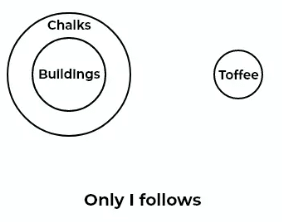
Q6:
Statements:
I. All the harmoniums are instruments.
II. All the instruments are flutes.
Conclusions:
I. All the flutes are instruments.
II. All the harmoniums are flutes.
(a) If only conclusion I is true.
(b) If only conclusion II is true.
(c) If either conclusion I or conclusion II is true.
(d) If neither conclusion I nor conclusion II is true.
Ans: (b)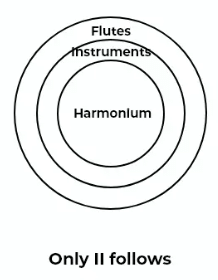
Q7:
Statements:
I. All liquids are solids.
II. Some solids are gases.
III. All gases are clouds
Conclusion:
I. Some clouds are solids
II. Some clouds are liquids
III. Some gases are liquids
IV. Some solids are clouds
(a) if only conclusion III is true.
(b) Only I and IV follows
(c) if either conclusion I or conclusion II is true.
(d) if neither conclusion I nor conclusion II is true
Ans: (b)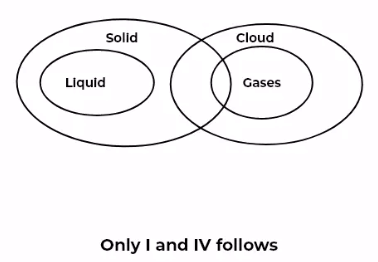
Q8:
Statements:
I. Some Cats are Rats.
II. All bats are tables.
III. All Rats are Bats.
Conclusion:
I. Some Cats are bats
II. All bats are rats
III. All tables are cats
IV. All bats are cats
(a) Only III & IV follow
(b) Only II follows
(c) Only I follows
(d) None follows
Ans: (c)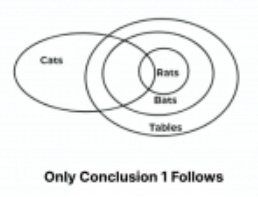 Q9:
Q9:
Statements
I. Some bags are books
II. All books are boxes
Conclusions
I. All Bags are boxes
II. No Book is boxes
(a) Only I follows
(b) Only II follows
(c) Only either I or II follows
(d) None follows
Ans: (d)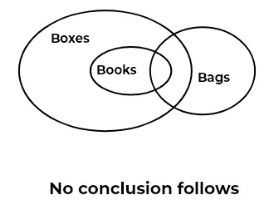
Q10:
Statements:
I. Some messages are whatsapp.
II. All Hikes are whatsapp.
III. All whatsapp are facebook.
Conclusion:
I. Some facebook are messages
II. All hikes are facebook
III. Some messages are hikes
IV. Some message are facebook
(a) Only I and II follow
(b) Only either III or IV follows
(c) Only I and either III or IV follow
(d) Only I, II and IV follows
Ans: (d)
|
177 videos|129 docs|197 tests
|
FAQs on Solved Examples: Syllogism - General Intelligence and Reasoning for SSC CGL
| 1. What are the rules for solving syllogism questions? |  |
| 2. How can I solve syllogism questions effectively? |  |
| 3. Can you provide an example of solving a syllogism question? |  |
| 4. Are there any shortcuts or tips for solving syllogism questions quickly? |  |
| 5. How can I improve my syllogism-solving skills? |  |




















